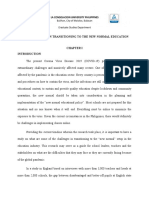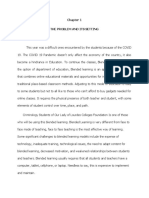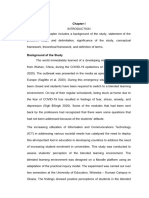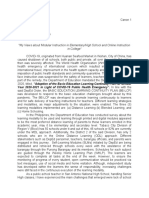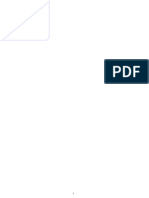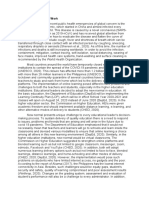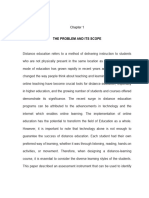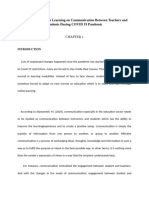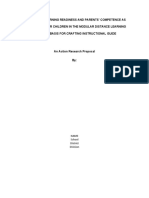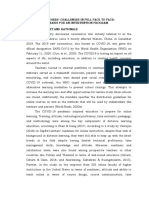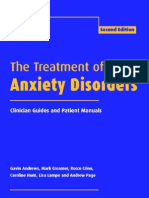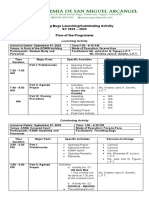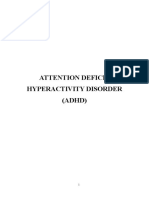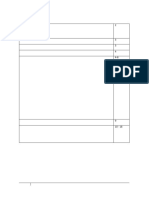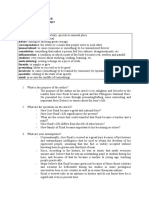Reflection Paper
Reflection Paper
Uploaded by
Georgelou Ace JaurigueCopyright:
Available Formats
Reflection Paper
Reflection Paper
Uploaded by
Georgelou Ace JaurigueCopyright
Available Formats
Share this document
Did you find this document useful?
Is this content inappropriate?
Copyright:
Available Formats
Reflection Paper
Reflection Paper
Uploaded by
Georgelou Ace JaurigueCopyright:
Available Formats
JAURIGUE, GEORGELAU ACE M.
Make a reflection paper of the ff.
> Different modalities of teaching in this time of pandemic.
The effects of the pandemic have affected and continue to affect education methods every day. The
education methods are not immune to the pandemic periods we are facing, so teachers must know how
to adapt their methods in such a way that teaching, and its quality, is not negatively affected. This study
provides an overview of different types of teaching methodology before, during, and after the
coronavirus disease (COVID-19) pandemic.
This study describes the different types of teaching (presence learning, blended learning, and
distance education) used in school (one private and one public) during the pandemic. A new teaching
methodology is proposed. The purpose of this study report is to share what we learned about the
response to COVID-19.
Results provide a basis for reflection about the pros and cons of teaching and learning modalities in
higher education. The current situation demands that we continue to rethink what is the best
methodology for teaching so that the education of students is not affected in any way. This study is
useful for learning about different teaching methods that exist and which ones may suit us best
depending on the context, situation, and needs of our students.
Year ago 2020, due to the declaration by the National Government, the educational centers could not be
opened, and they had to optimally adapt to this fact. Each educational center had to base its teaching on
the online mode and to adapt teachers and students to this new reality: videoconferencing software was
used to avoid social disconnection, students were disoriented, ignorance of new tools had to be
overcome to teach classes, and the evaluation systems need to be redesigned. The pandemic revealed
the shortcomings of educational institutions, mainly about the infrastructures and the training of
teachers in the Information and Communication Technology (ICT) tools. However, it also meant
improvements. The teachers were trained in new online methodologies and showed interest in learning
new teaching tools in the face of the new reality and challenges that arose.
> Insights about the quality of education in this type of pandemic.
Education is no exception students from privileged backgrounds, supporter by their parents and
eager and able to learn could find their way past closed school doors to alternative learning
opportunities.
This crisis has exposed the many inadequacies and inequalities in our educational systems, from access
to the broadband and computers needed for online education and supportive environment needed to
focus on learning up to the misalignment between resources and needs.
Teachers also had to adapt to new pedagogical concept and modes of delivery of teaching, for teach
they may not have been trained. In particular learners most marginalized groups who don't have access
to digital learning resources or lack of resilience and engagement to learned on their own are at risk and
falling behind.
If schools are slow to return to prior levels of performance, the growth losses will be proportionately
higher. Of course, slow growth from the loss of skills in today's students will only be seen in the long
term. However when considered over this term, the impact become significant. In other words
countries will continue to face reduced economic well-being even if their schools immediately return to
pre-pandemic levels of performance.
You might also like
- Learn German With Stories - Dino - Andre Klein - 1 PDFDocument9 pagesLearn German With Stories - Dino - Andre Klein - 1 PDFabas00314% (14)
- Research Proposal The Challenges in Transitioning To The New Normal Education 1Document8 pagesResearch Proposal The Challenges in Transitioning To The New Normal Education 1divina alvarez100% (1)
- Jacinta Grimmett Teaching ResumeDocument2 pagesJacinta Grimmett Teaching Resumeapi-419554008No ratings yet
- RationaleDocument56 pagesRationaleWinnie LaraNo ratings yet
- Thesis Ni PadaDocument9 pagesThesis Ni PadaSharina ObogNo ratings yet
- What Strategic Measure Should You Apply in Order To Push Through The Blended and Flexible Learning?Document3 pagesWhat Strategic Measure Should You Apply in Order To Push Through The Blended and Flexible Learning?John Mark HermedillaNo ratings yet
- STEP3Document10 pagesSTEP3Jared OlegarioNo ratings yet
- ResearchDocument22 pagesResearchMervin BauyaNo ratings yet
- Strategic ManagementDocument11 pagesStrategic ManagementMalik Aali AhsanNo ratings yet
- Blended Learning Platforms As Supplementary Learning Tool For Home-Based LearningDocument7 pagesBlended Learning Platforms As Supplementary Learning Tool For Home-Based LearningPatricia De Guzman Buenaventura100% (1)
- Updated Chapters 1-4 B14G3Document25 pagesUpdated Chapters 1-4 B14G3Lablab AbuevaNo ratings yet
- Revealing The Lived Experieces of Students On Modular Learning: A PhenomenologyDocument32 pagesRevealing The Lived Experieces of Students On Modular Learning: A PhenomenologyJeclyn FilipinasNo ratings yet
- Philippine Education in New NormalDocument2 pagesPhilippine Education in New NormalHakdogNo ratings yet
- Revised DraftDocument9 pagesRevised DraftqayunicornNo ratings yet
- Chapters 1 3 Oct. 27 2022Document32 pagesChapters 1 3 Oct. 27 2022Francis DecenaNo ratings yet
- 11-GAS (EDITING) - PROBLEMS-ENCOUNTERED-BY-THE-SELECTED-SENIOR-HIGH-SCHOOL-ON-THE-NEW-NORMAL-EDUCATION-AT-ST-AutoRecoveredDocument15 pages11-GAS (EDITING) - PROBLEMS-ENCOUNTERED-BY-THE-SELECTED-SENIOR-HIGH-SCHOOL-ON-THE-NEW-NORMAL-EDUCATION-AT-ST-AutoRecoveredRuel NezortadoNo ratings yet
- A Comparative Study of The Academic Performance of USL-SHS Students Before and During Pandemic IDocument10 pagesA Comparative Study of The Academic Performance of USL-SHS Students Before and During Pandemic IJanina Llanto100% (1)
- My Views About Modular Instruction in ElementaryDocument4 pagesMy Views About Modular Instruction in ElementaryErica CanonNo ratings yet
- Get To Know More About Blended Learning in The Philippines PDFDocument8 pagesGet To Know More About Blended Learning in The Philippines PDFMarquille De LapuzNo ratings yet
- Coping Mechanism of The Students On The Challenge of Distance LearningDocument8 pagesCoping Mechanism of The Students On The Challenge of Distance Learningrosejen jenjenNo ratings yet
- PORTFOLIO - Learning Delivery Modalities - Happy LagataDocument24 pagesPORTFOLIO - Learning Delivery Modalities - Happy LagataSandy LagataNo ratings yet
- MissionDocument13 pagesMissionR.J PolvorosaNo ratings yet
- Business Statistics PDFDocument17 pagesBusiness Statistics PDFSiddhesh jadhavNo ratings yet
- STI ThesisDocument12 pagesSTI ThesisKurt Francis Hendrick S. PascualNo ratings yet
- The Effectiveness of New Normal System On LearnersDocument30 pagesThe Effectiveness of New Normal System On LearnersJoy Sun CardsNo ratings yet
- Manuscript EDITED 7Document29 pagesManuscript EDITED 7Zaira BocarNo ratings yet
- Ibat Ibang Pista Sa PilipinasDocument17 pagesIbat Ibang Pista Sa Pilipinasaujsc.jmsequitoNo ratings yet
- Background Impact of Covid-19 Pandemic On Teaching and Learning Across Northern SamarDocument4 pagesBackground Impact of Covid-19 Pandemic On Teaching and Learning Across Northern SamarSky ChingNo ratings yet
- Forda Go Ang Ferson With Reference LinkDocument4 pagesForda Go Ang Ferson With Reference LinkJonhlaurence NualNo ratings yet
- Reflective Paper On Current Issues and Trends in Education: I. II. BodyDocument11 pagesReflective Paper On Current Issues and Trends in Education: I. II. BodyCaironisah Mocadi HmdNo ratings yet
- Chapter 1-2 The Impact of Modular Learning ApproachDocument17 pagesChapter 1-2 The Impact of Modular Learning ApproachArzhel Junio75% (4)
- Research PaperDocument43 pagesResearch PaperKeziah Mae Fernan ButalNo ratings yet
- Research of MaimaiDocument7 pagesResearch of MaimaiThricia SalvadorNo ratings yet
- Reaction Paper 1Document4 pagesReaction Paper 1Dioleta OmanioNo ratings yet
- Dr. Tri Wintolo Apoko, M.PD: Cherry Love B. Montales, Ed.D: of Hunker Since 2020, An Academic Staff in The Study ProgramDocument5 pagesDr. Tri Wintolo Apoko, M.PD: Cherry Love B. Montales, Ed.D: of Hunker Since 2020, An Academic Staff in The Study ProgramKim ParoneNo ratings yet
- Mangayao, Janica Mae Gomez - Maed106 - Req - FirstsemDocument18 pagesMangayao, Janica Mae Gomez - Maed106 - Req - FirstsemJanica Mae MangayaoNo ratings yet
- Chapages Lusanta 3Document137 pagesChapages Lusanta 3Mary Jiel Dionesio LansanganNo ratings yet
- Thesis For Final DefendDocument75 pagesThesis For Final Defendvenqzcyss01No ratings yet
- Chapter 1Document26 pagesChapter 1Nichole AlbaracinNo ratings yet
- PR NaminDocument13 pagesPR NaminitsmedidangNo ratings yet
- Midterm Term PaperDocument10 pagesMidterm Term PaperValerie MarianoNo ratings yet
- Ar Proposal On MDLDocument23 pagesAr Proposal On MDLAglanot ISNo ratings yet
- Implementing Modular Distance LearningDocument72 pagesImplementing Modular Distance LearningWMSU Marlon GrandeNo ratings yet
- Background of The StudyDocument23 pagesBackground of The Studytrixy AntivoNo ratings yet
- E-Turo: A Study On The Impacts of Online Learning Approach Among The Grade 7 Students of Judge Feliciano Belmonte Sr. High SchoolDocument8 pagesE-Turo: A Study On The Impacts of Online Learning Approach Among The Grade 7 Students of Judge Feliciano Belmonte Sr. High Schoolromeojunior alinaoNo ratings yet
- Parents-Teachers Perceptions On The Impact of Modular LearningDocument16 pagesParents-Teachers Perceptions On The Impact of Modular LearningJosenia Constantino79% (24)
- Assignment BDocument10 pagesAssignment BVenus BoacNo ratings yet
- Thesis 1 - FinalDocument62 pagesThesis 1 - Finaljomeryalonsagay81No ratings yet
- Factors Affecting The Face - To - Face ClassesDocument21 pagesFactors Affecting The Face - To - Face Classescris addunNo ratings yet
- Outline DefenseDocument48 pagesOutline DefenseRina Lou Lumactud-DumukNo ratings yet
- GRADE - 12 - THESIS - Vanessa MacabatalDocument17 pagesGRADE - 12 - THESIS - Vanessa Macabataljack macabatalNo ratings yet
- Grade 12 Thesis 113833-1Document17 pagesGrade 12 Thesis 113833-1jack macabatalNo ratings yet
- How Did The Education System Change During The PandemicDocument19 pagesHow Did The Education System Change During The Pandemicrhea.lopezNo ratings yet
- Philippine Education Article AnalysisDocument5 pagesPhilippine Education Article AnalysisNESTOR SANDOVALNo ratings yet
- Teachers' Challenges in Full Face To FaceDocument3 pagesTeachers' Challenges in Full Face To FaceJeny Leono Saavedra SardomaNo ratings yet
- The Contemporary PedagogyDocument2 pagesThe Contemporary PedagogyVALDEZ, Jericson T.No ratings yet
- RESEARCH101Document8 pagesRESEARCH101cute75767No ratings yet
- Chapter 1 SampleDocument11 pagesChapter 1 SampleKristelle De VeraNo ratings yet
- Chapter 1Document4 pagesChapter 1Angela SernatNo ratings yet
- GRADE 12 THESIS Vanessa MacabatalDocument16 pagesGRADE 12 THESIS Vanessa Macabataljack macabatalNo ratings yet
- The New Education - Fighting Technology (and Boredom) for the Attention of StudentsFrom EverandThe New Education - Fighting Technology (and Boredom) for the Attention of StudentsNo ratings yet
- Compound Noun WorksheetDocument3 pagesCompound Noun WorksheetJason Thomas100% (1)
- HomeroomClub OFFICERS 2023 2024Document1 pageHomeroomClub OFFICERS 2023 2024Jean RomarNo ratings yet
- The Treatment of Anxiety Disorders Clinician Guides and Patient ManualsDocument624 pagesThe Treatment of Anxiety Disorders Clinician Guides and Patient Manualsladylife92% (12)
- DLL Q2 W4 Pe M2 Table TennisDocument8 pagesDLL Q2 W4 Pe M2 Table TennisRuby RoseNo ratings yet
- Itto - Communication Management PDFDocument1 pageItto - Communication Management PDFtippurajNo ratings yet
- How To Make Your Plastic Free LapbookDocument2 pagesHow To Make Your Plastic Free LapbookJessica SabbatelleNo ratings yet
- MusaTaib ResumeDocument1 pageMusaTaib ResumeHassan.AnwarNo ratings yet
- Teenage Brains Are Malleable and Vulnerable, Researchers SayDocument5 pagesTeenage Brains Are Malleable and Vulnerable, Researchers SayMauxi RendonNo ratings yet
- Diagnostics 11 01182 v2Document12 pagesDiagnostics 11 01182 v2liwajagoNo ratings yet
- CtsDocument59 pagesCtsPrudhviNo ratings yet
- Concept 2Document2 pagesConcept 2Irene InsoNo ratings yet
- Grade 7 Health Managing Stress PowerpointDocument34 pagesGrade 7 Health Managing Stress PowerpointJulyfer CabisoNo ratings yet
- How To Write Literature Review and MethodologyDocument6 pagesHow To Write Literature Review and Methodologyakjnbowgf100% (1)
- Dialect EngDocument11 pagesDialect EngkeylimikadzeNo ratings yet
- Programme TemplateDocument2 pagesProgramme TemplateKristine Jane SereñoNo ratings yet
- Task Card 2 Zacarias Legit Na ToDocument3 pagesTask Card 2 Zacarias Legit Na ToMaryam LoayonNo ratings yet
- Organize Remember Everything Updated PDFDocument18 pagesOrganize Remember Everything Updated PDFVishal JainNo ratings yet
- SSVT Youth SiddhaDocument5 pagesSSVT Youth SiddhaGopal GopinathNo ratings yet
- Family Members HandoutsDocument10 pagesFamily Members HandoutsAdrianoGasparNo ratings yet
- ADHD - EnglishDocument64 pagesADHD - EnglishNataly Xanthy100% (1)
- Public Notice Transfer Migration of MBBS & BDS StudentsDocument4 pagesPublic Notice Transfer Migration of MBBS & BDS StudentsTayyab AfzalNo ratings yet
- MSC Dissertation Guide Sept 2021 RevisedDocument18 pagesMSC Dissertation Guide Sept 2021 RevisedAparna RoutNo ratings yet
- Microsoft Access - Module 1 - IntroDocument7 pagesMicrosoft Access - Module 1 - IntroinfocomNo ratings yet
- As Web Design q1 Dodea-AmDocument3 pagesAs Web Design q1 Dodea-AmMW Blue OnKeysNo ratings yet
- Course 1 2nd Half Sugg PDFDocument1 pageCourse 1 2nd Half Sugg PDFMd Shafeeque AlamNo ratings yet
- Rizal As Teacher and Pupil - RHDAA AnswersDocument3 pagesRizal As Teacher and Pupil - RHDAA AnswersMaryJoyceTrajanoNo ratings yet
- UET Research Proposal TemplateDocument9 pagesUET Research Proposal TemplateEngr AhmadNo ratings yet
- Agreement For SaleDocument5 pagesAgreement For SaleVenkata Ramana PothulwarNo ratings yet

